Chapter 14 - Aging and Families
The United States of America is inhabited by many diverse people, including distinguishable generations of society's members based on age. Gerontology is the scientific study of the processes and phenomena of aging and growing old. There are many definitions of being elderly. The government typically sets age 65 to begin the elderly years, the American Association of Retired Persons finds 55 to be the eligible age of membership, and many elderly define their 70s or 80s as the time they begin to feel elderly. Gerontology is multi-disciplinary, with medical and biological scientists, social scientists, and even financial and economic scientists all studying the processes of aging from their discipline's point of view.
Social Gerontology is the sociological subfield of gerontology, which focuses on the nonphysical and social aspects of aging. Sociology focuses on the broad understanding of the elderly experience, their health, their emotional and social wellness, and their quality of life, just to mention a few aspects. How many elderly lived in the U.S. in 2008? Family Gerontology is the subfield that focuses on the family experiences of elderly persons.
Table 1. Numbers and Percent of United States Population Aged 65 and Over, 2008
| ≤ 14 Years of Age | 15-64 Years Old | Elderly | United States Total |
|---|---|---|---|
| 61,146,753 (20.1%) | 203,987,724 (67.1%) | 38,690,169 (12.7%) | 303,824,646 (100%) |
Estimates retrieved 17 June 2008 from https://www.cia.gov/library/publications/the-world-factbook/print/us.html
The future growth of the U.S. elderly population is immense in comparison to previous census tabulations and growth rates. In Figure 1 below you see tremendous projected growth in the United States, where the elderly now comprise only 1 in 8 members of U.S. society but will in 2050 comprise 1 in 5. In Figure 2 below you can see that the oldest old -- 85 years and older -- is also growing rapidly. This means that in general more people are living longer. In fact, there are more Centenarians than ever before. A Centenarian is a living person who has had his or her 100th birthday. U.S. Census counts indicated about 37,000 centenarians in 1990 and about 50,000 in 2000 (see Kestenbaum and Reneé, 2006, retrieved 19 July 2008 from http://findarticles.com/p/articles/mi_qa4030/is_200607/ai_n17183322).
Figure 1. Estimated Percentage of U.S. Population That Will Be Elderly and Non-Elderly, 2000-2050
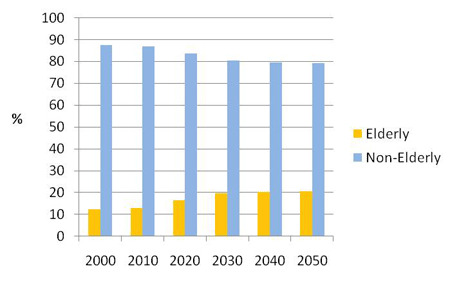
Estimates retrieved 18 June 2008 from http://www.census.gov/ipc/www/usinterimproj/natprojtab02a.pdf Table 2a. Projected Population of the United States, by Age and Sex, 2000 to 2050
Figure 2. Estimated Percentage of U.S. Population That Will Be 65-84 and 85+, 2000-2050
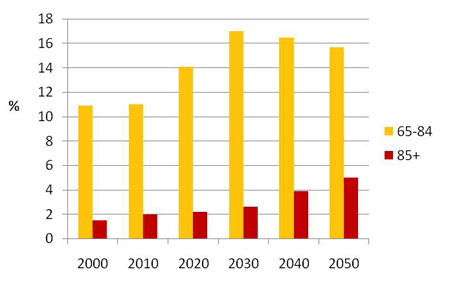
Estimates retrieved 18 June 2008 from http://www.census.gov/ipc/www/usinterimproj/natprojtab02a.pdf Table 2a. Projected Population of the United States, by Age and Sex, 2000 to 2050
Understanding the Generations of Life
In many societies the elderly are revered (especially Asian societies). Filial Piety is the value, respect, and reverence of one's elderly, which is often accompanied by caregiving and support of the elderly. Grandparents and even great-grandparents are valued and included in the home of the mother, the father, and their children. These families are enriched by three and sometimes four generations of family members supporting the socialization of the younger members of the family. In Western countries, the elderly and their extended family are considered co-equals and mutually independent until circumstances necessitate assistance from children and other family members.
Life course is an ideal sequence of events and positions the average person is expected to experience as he/she matures and moves through life. Dependence and independence levels change over the life course. In Figure 3 below, you can see that from birth to teen years, children's levels of dependence are relatively high and their levels of independence are relatively low. Newborns have little ability to nurture others, but as they are socialized and grow into their later-teen roles things change. By young adulthood, independence is a prime value, which leads many to move out on their own and gain their own experiences (like most of you did).
Figure 3. Diagram of Dependence and Independence Over the Life Course
| Stage | Dependence or Independence Levels | Own Ability to Nurture |
|---|---|---|
| Birth to pre-school | Totally Dependent | Low↓ |
| Pre-school | Mostly Dependent | Low↓ |
| School to pre-teen | Somewhat Dependent | Low↓ |
| Teen to young adult | Increasingly Independent |
Moderate→ |
| Young adult | Moderately Independent | Moderate→ |
| Young Married | Mostly Independent | Somewhat High↑ |
| Young Parents | Almost Independent | High↑ |
| Parents | Independent |
High↑ |
| Grandparents | Extremely Independent | High↑ |
| Great-Grandparents | Somewhat Independent | Moderate→ |
© 2009 Ron J. Hammond, Ph.D.
Young adults' ability to nurture is moderate but often dormant, since most pursue avenues of preparation for their adult lives rather than immediately beginning their own families. Married and cohabiting couples are much more independent and capable of nurturing and remain so throughout the grandparenting years. As the life course progresses into later life, the oldest elderly begin to lose their independence as their health declines to the point that their resources lag behind the daily demands placed upon them. This is because all of us experience senescence. Senescence is the social, emotional, biological, intellectual, and spiritual processes associated with aging (www.senescence.info).
For many in our modern societies, aging is feared, vilified, and surgically and cosmetically repaired. We do not like being “off our game,” and senescence is viewed as a weakness. Yet many elderly find their lives very satisfying. And they tend to report higher levels of self-esteem than do younger members of society. Because we tend to value youth, youthful appearance, and youthful-centered entertainment, biases appear in the U.S. There are in the United States many who hold deeply held biases and prejudices against the elderly. Ageism is the prejudice and discrimination against a person based on his/her chronological age.
Ageism is a unique form of bias. One may be prejudiced against another racial group, cultural or ethnic group, or religious group while never being at risk of becoming a member of that group. Ironically, ageist people are aging right now and will be until the day they die -- they are essentially biased against their own future status.
For those who seek understanding of the elderly, there are three social theories that might help to understand the elderly and their later-life experiences. These are listed in order of their professional value by gerontologists, who study aging-related psychosocial issues.
Continuity Theory claims that older adults maintain patterns in their later years that they had in their younger years. The elderly adapt to the many changes that accompany aging using a variety of effective personal strategies they developed earlier in their lives. For example, those who participated in outdoor activities in their younger years tend to continue to do so as older adults -- although they tend to accommodate their health and fitness limitations as they deem appropriate.
Activity Theory claims that the elderly benefit from high levels of activities, especially meaningful activities that help to replace lost life roles after retirement. The key to success in later-life is staying active and by doing so resisting the social pressures that limit an older person's world (Google "Robert Havighurst and Aging").
Disengagement Theory claims that as elderly people realize the  inevitability of death and begin to systematically disengage from their previous youthful roles, society simultaneously prepares the pre-elderly and elderly to disengage from their roles. This was the first formal aging theory that fell short of credibility because the scientific data did not support its assumptions. There is, on the other hand, quite a bit of support for the Continuity and Activity theories (see The Encyclopedia of Aging online at http://www.medrounds.org/encyclopedia-of-aging/2005/12/index.html).
inevitability of death and begin to systematically disengage from their previous youthful roles, society simultaneously prepares the pre-elderly and elderly to disengage from their roles. This was the first formal aging theory that fell short of credibility because the scientific data did not support its assumptions. There is, on the other hand, quite a bit of support for the Continuity and Activity theories (see The Encyclopedia of Aging online at http://www.medrounds.org/encyclopedia-of-aging/2005/12/index.html).
To really understand the elderly today, you have to understand the larger social changes that have transpired over the last century. Around 1900, U.S. elderly held a more cherished place in the hearts of younger family members. Most homes were intergenerational, with grandparents, parents, and children all living in the same home and more often with kin on the wife's side being the social connection around which three generations would live (see Dorian Apple Sweetser, 1984, “Love and Work: Intergenerational Household Composition in the U.S. in 1900,” Journal of Marriage and the Family, Vol. 46, No. 2 (May 1984), p. 289-293, retrieved 18 June 2008 from http://www.jstor.org/stable/352460?seq=1).
In 2000, the U.S. Census Bureau reported that there were 105.5 million households in the country (report C2KBR/01-8retrieved on 18 June 2008 from http://www.census.gov/prod/2001pubs/c2kbr01-8.pdf). Table 2 below reports that only 3.7 percent, or nearly 4 million households, were multigenerational. It probably feels normal to you to not have older relatives live in your home. The point is that in years past elderly family members were considered a valuable asset with their wisdom and support of their children and grandchildren.
Theorizing Later Life
Modernization Theory claims that industrialization and modernization have lowered the power and influence the elderly once had, which has led to much exclusion of elderly from community roles. Even though this theory is not as well established and is somewhat controversial, it has made a place in science for understanding how large-scale social forces have impacted the individual and collective lives of the elderly. In our modern societies, the economy has grown to a state that has created new levels of prosperity for most, the new technologies have outpaced the ability of the elderly to understand and use them, and the elderly are living much longer and are not essential to the economic survival of the family as was the case for millennia. Modernization can help us to understand why the elderly have become stigmatized and devalued over the last century.
Who make up the generations of our day? Look at Figure 4 below to see birth rates and generation labels for the United States. First notice the red and blue lines. The red represents the Crude Birth Rate, which is the number of births per 1,000 population in a given year. The blue line represents the General Fertility Rate, which is the number of live births per 1,000 women aged 15-44. Both CBR and GBRs show a pattern of birth rates that were relatively high when the World-At-War Generation was born. Birth rates declined with the Great Depression until 1946 (the commencement of the Baby Boom). The Baby Boom represented a surge in birth rates that endured from 1946-1964 and declined to pre-Boom rates in 1965. Generation X or “Gen X” represents the children of the Baby Boomers, which spilled into Generation Y or the “Millennials,” which by most accounts are still being born.
Figure 4. United States General Fertility Rates and Crude Birth Rates from 1909-2005 with Generation Markers for Baby Boomers and Generations X, and Y
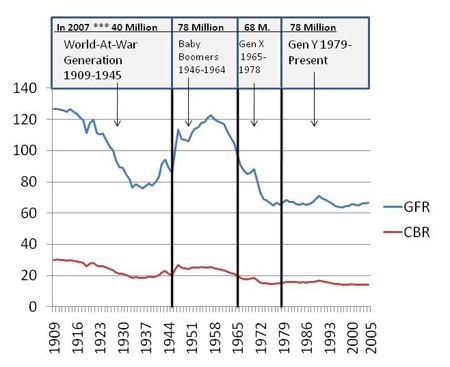
Data extrapolated from U.S. Census; retrieved 11 February 2008 from http://1.usa.gov/1disX0. Wikipedia offers a concise article on today's generations and these data here were extracted in part from it and the references included therein. Note that there is no universally agreed upon definition of generations other than the Baby Boomers.
The World-At-War Generation is slowly disappearing from the U.S. population landscape. On the 8th of June, 2008, the last living Veteran of World War I was honored by the White House and Congress. Frank W. Buckles fought in WWI and was held prisoner in Manila during World War II (retrieved on 19 June 2008 from http://www.cnn.com/2008/US/03/07/war.veteran). Also the U.S. Veterans Bureau reported that there were 2,911,900 WWII veterans as of 30 September 2007, with about 900 WWII veterans passing away each day. They also reported that 39.1 percent of all U.S. veterans were aged 65 and older (retrieved 19 June 2008 from http://www1.va.gov/vetdata/docs/4X6_spring08_sharepoint.pdf).
The majority of the elderly today are women. If you consider the elderly as being divided into three life stages, you can discern just how the elderly are comprised comparing males to females. The Young-old are 65-74 years, the Middle-old are 75-84 years, and the Old-old are 85+ years. In 2005 there were more females than males in all three age groups. This is because women, in most countries of the world, have a higher life expectancy than men. Life Expectancy is the average numbers of years a person born today may expect to live.
The U.S. life expectancy today is about 80 for females and 75 for males (worldwide it 70 for females and 66 for males; see www.prb.org, 2007 Population Data Sheet, retrieved 19 June 2008). Life expectancies have increased dramatically over the last 50 years in the Western nations of Canada, United States, Australia, Japan, and Western Europe. Overall, men and women can expect to live longer than they did in the 1940s-1990s.
Figure 5. Numbers of U.S. Elderly Population Ages 65-74, 75-84, and 85+
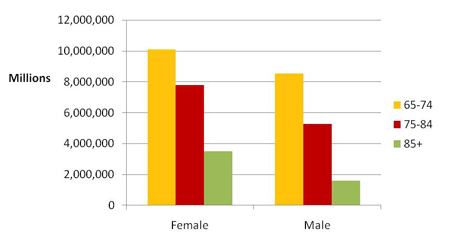
Data retrieved 19 June 2008 from Table 1. Resident population, by age, sex, race, and Hispanic origin: United States, selected years 1950-2005, from http://www.cdc.gov/nchs/data/hus/hus07.pdf#001
The sex ratio in the quote above, which was 44 for persons 58 to 89, would be interpreted as 44 males per 100 females. I found this quote about U.S. elderly males and females on census.gov:
“Perhaps no feature of the oldest old is as striking as their sex ratio (the number of males per 100 females), which was 39 in 1994 (982,000 males and 2.5 million females). The sex ratio in the United States was 44 for persons 85 to 89 years old, and only 26 for persons 95 to 99 years old. In comparison, the sex ratio was 82 for persons 65 to 69 years old." (Retrieved 19 June 2008 from http://www.census.gov/population/www/pop-profile/elderpop.html.)
The Baby Boomers represented 78.2 million U.S. citizens as of 1 July 2005 (see http://www.census.gov/Press-Release/www/releases/archives/facts_for_features_special_editions/006105.html). This large cohort of society's member is moving en mass into the ranks of the elderly. A Cohort is a group of people who share a statistical or demographic trait, such as those born between 1946 and 1964. Nearly 8,000 Baby Boomers turned 60 each day in 2006. The U.S. Census estimates that 57.8 million Baby Boomers will be around in 2030, after they've all retired. One issue for gerontologists is the financial strain the Baby Boomers will place on the rest of society once they are retired. Most speculate that Baby Boomers will not receive the same from the Social Security Administration benefits their parents and grandparents enjoyed.
The children of the Baby Boomers were called the Generation X children or the “Baby Bust,” because they were born in post-Boom, low-fertility-rate years. They were different from their parents. They grew up with the computer age and came to computer technology much like an immigrant comes to a new country. This cohort grew up in an economic state of greater posterity than did previous generations. Generation Y, or Millennials, are also called the “Internet Generation" or "Screenagers,” because they grew up with TV, video games, cell phones, PDAs, and movie screens. Each generation is culturally distinct compared to the previous ones, even though much still remains in common. There is a good chance that children of Generation Y parents will be better skilled than their parents with a technology that has not yet been invented. Such has been the case in the last three generations.
In Tables 2 & 3 below you see the increasing life expectancies in the U.S. The elderly of the future will be expected to live longer than any elderly in the history of the United States and world. Being born in the U.S. affords the average member of society a longer life. In Table 3 below you can see that North American children are born with higher life expectancies than other children around the world. By far, being born in Japan and Hong Kong would provide the absolute highest life expectancy at birth at 82 years for the total.
Table 2. United States Life Expectancies
| Year | Total | Male | Female |
|---|---|---|---|
| 1970 | 70.8 | 67.1 | 74.7 |
| 1980 | 73.7 | 70.0 |
77.4 |
| 1990 | 75.4 | 71.8 | 78.8 |
| 2000 |
77.0 | 74.3 | 79.7 |
| 2010* | 78.5 | 75.6 | 81.4 |
| 2015* | 79.2 |
76.2 | 82.2 |
*Projected estimates (retrieved 19 June 2008 from Table 98: Expectations of Life at Birth, 1970-2004, and Projections, 2010 and 2015; http://www.census.gov/compendia/statab/tables/08s0098.pdf)
Table 3. 2007 World and Regional Life Expectancies
| Region | Total | Male | Female |
|---|---|---|---|
| World |
68 | 66 | 70 |
| Africa | 53 | 52 | 54 |
| N. America | 78 | 70 | 81 |
| L. America | 73 | 70 | 76 |
| Asia | 68 | 67 | 70 |
| Europe | 75 | 71 | 79 |
| Oceania | 75 | 73 | 78 |
(www.prb.org, 2007 Population Data Sheet , retrieved 19 June 2008)
In fact, all regions of the world are growing older. The developing countries are aging the fastest. Consider the screen capture and color map in Figure 6, taken from the Population Reference Bureau World Population data Sheet 2007, Page 6.
Figure 6. Population Aging Is Occurring Worldwide
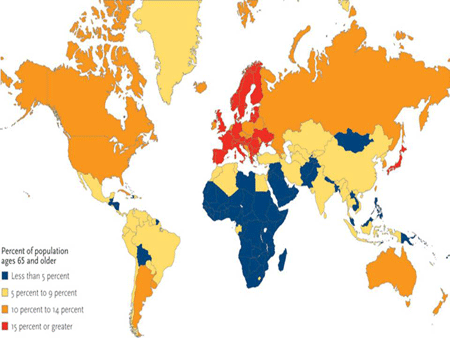
Retrieved 19 June 2008 from WWW.PRB.org Population Data Sheet 2007: Sources: C. Haub, 2007 World Population Data Sheet, and United Nations Population Division
Over the past half-century, both the worldwide drop in fertility and concurrent rise in life expectancy have led to the gradual aging of the world's population. Look at Table 4 below. Since 1950, the share of persons ages 65 and older has risen from 5 percent to 7 percent worldwide. As the map shows, Europe and Japan have led the way, with North America, Australia, and New Zealand close behind. However, older persons are now more than 5 percent of the inhabitants in many developing countries and by 2050 are expected to be 19 percent of Latin America's population and 18 percent of Asia's.
Table 4. Worldwide Percent of Persons Ages 65 and Older
| 2007 | 2025 | 2050 | |
|---|---|---|---|
| World | 7 | 10 | 16 |
| Industrialized Countries | 16 | 21 | 26 |
| Developing Countries |
6 | 9 | 15 |
| Europe | 16 | 21 | 28 |
| North America | 12 | 18 | 21 |
| Oceania | 10 | 15 | 19 |
| Latin Am. & Caribbean | 6 | 10 | 19 |
| Asia | 6 | 10 | 18 |
| Africa |
3 | 4 | 7 |
Retrieved 19 June 2008 from WWW.PRB.org Population Data Sheet 2007: Sources: C. Haub, 2007 World Population Data Sheet, and United Nations Population Division
Challenges of Being Elderly and Single
As mentioned, elderly women outlive elderly men. Widowhood occurs when one's spouse dies. Widows are surviving wives, and Widowers are surviving husbands. As a young college student you probably don't worry about ever being a widow or widower. Justifiably, you shouldn't have to based on statistical probabilities. In fact, you are more likely to lose a spouse via death than via divorce. Do some math with me. If you are female and marry a guy who is two years older than you are, and his life expectancy is five or six years shorter than yours, then you will likely be a widow at some time in your life and may live 6-8 years as such. One sub-discipline of gerontology is thanatology. Thanatology is the scientific study of death and dying. Thanatology informs those who provide support and counsel to the dying.
How we define death, both our own and the death of others, is very much influenced by the cultural definition of death we incorporated into our own values while growing up. Most of us are related to someone who died in the last 24 months. It's very common for college students about your age to have lost a great aunt/uncle, a great grandparent, and even a grandparent. It's not so common for you to have lost you own parent or sibling. Grief is the feeling of loss we experience after a death, disappointment, or tragedy. When you experience grief, you are said to be in bereavement. Bereavement is the circumstances and conditions that accompany grief.
Dr. Elisabeth Kübler-Ross published her work as the stages of grief (see “On Death and Dying," 1973, Routledge Press). These are
- Denial = “All is fine" or "It didn't happen”
- Anger = “Why me?” or “I hate God for this”
- Bargaining = "I'll be a better person if you (God) will just let him live”
- Depression = “All is lost" or "why try?”
- Acceptance = ”We'll be okay” or “We can get through this together”
I've noticed that we all grieve when things disappoint us, when someone dies, or even when we break up with someone. I've seen my seniors grieve to a certain degree when they did not get into graduate school their first try. We all grieve, and we all grieve in our own way. Studies show that most people experience denial, anger, bargaining, depression, or acceptance, but there exists some disagreement on the part about cycling through Kübler-Ross' stages in any order.
The study of aging would not be complete without focusing on family relationships and roles. Of the over 40,000,000 (millions) of elderly in the U.S., about 6 million still work for pay. About 7 million are taking adult education courses. About 21 million are married, and about 13 million are widowed. Only 1,400,000 live in nursing homes. About 32 million own their homes. In the 65-plus age group, there are only 73 men per 100 women (data retrieved from U.S. Census on 9 February 2010 from http://www.census.gov/Press-Release/www/releases/archives/facts_for_features_special_editions/013384.html). These trends lead to some important family-related issues that need to be discussed here.
Just how the future of elderly family relationships will be in coming decades is very difficult to predict. Many elderly live single (regardless of any wishes to the contrary). The U.S. Census Bureau reported that among 65+ ages there were 3,500,000 elderly single men with no spouse or partner and 10,400,000 elderly women with no spouse or partner (retrieved 10 Feb. 2010 from http://www.census.gov/population/www/socdemo/age/older_2008.html). The imbalance among elderly single men and women is obvious. Although many single marrieds might enjoy an intimate relationship with a partner or spouse, the rewards and costs are different between men and women in these age ranges. It is true that their combined retirement incomes and living expenses might be increased together and therefore appealing to both, but elderly women are faced with a biological truth that makes the possibility of another long-term intimate relationship less appealing -- that is that men die much sooner than women. To marry a 65-year-old man is to take on a caregiver position that in 5-10 years will place the women in a stressful, very demanding, and perhaps overwhelming role.
Many widows have already been through something like this with their deceased husbands. Many divorcees and never marrieds have found their life patterns to be very established and difficult if not impossible to change. Thus, many elderly remain single and have friendships and intimacies without the long-term commitments that come with cohabiting or marrying again.
What do the trends for elderly unmarrieds in later life suggest to us? Quite simply more divorced and separated elderly are predicted. Figure 7 below shows the actual trends in increasing divorced elderly from 1963-2003. There are higher proportions of divorced and separated elderly now than in the past. This trend is not the same for widowhood. In other words, there is only a slight increase in widowhood compared to a dramatic increase in being divorced or separated.
Figure 7. Percent of U.S. Who Are Elderly Divorced (Age 65 & Over) by Females and Males, 1963-2003 U.S. Census Reports

Another trend, which is documented in Figure 8 below, is the increasing numbers of those in the pre-elderly stages of life (ages 30-64). There are increased rates of divorcing and remaining divorced. The Baby Boomers were born between 1946 and 1964. They turn 65 between 2011 and 2029. This cohort in the U.S. has the highest documented divorce rates of any age-related cohort ever studied in the United States (see R. M. Kreider, “Number, Timing, and Duration of Marriages and Divorces,” Figures 1a & 1b: Percent of Men and Women Ever Divorced, Among Those Ever Married by Selected Ages, for Selected Birth Cohorts: 2001. U.S. Bureau of the Census, Current Population Reports: P70-97, Washington D.C.)
The numbers of elderly will nearly double by the time all the Baby Boomers reach age 65 in 2030. This leads to the conclusion that when the Baby Boomers reach age 65 (beginning in the year 2011), the prevalence of divorced elderly will rise to an even higher level because of the sheer volume of divorced Baby Boomers who will also, for whatever reason, remain divorced into their later years.
Figure 8. Percent of U.S. Elderly Pre-Elderly Who Are Divorced (Age 30-64) by Females and Males, 1963-2003 U.S. Census Reports

Not all retirement years are created equally. Figure 9 shows the income comparisons of married versus divorced elderly males and females from 1994-2004. Notice that the highest median income levels were for married males. Divorced males had the next highest levels, and divorced females (represented by the orange line) came in third. Married females came in last, in part because this generation of elderly had a relatively high rate of traditional homemakers, who have fewer Social Security retirement benefits than their husbands.
Figure 9. Median Income Levels for All Races of United States Elderly (Age 65 & Over) Male & Female Married Compared to Male & Female Divorced, 1994-2003 U.S. Census
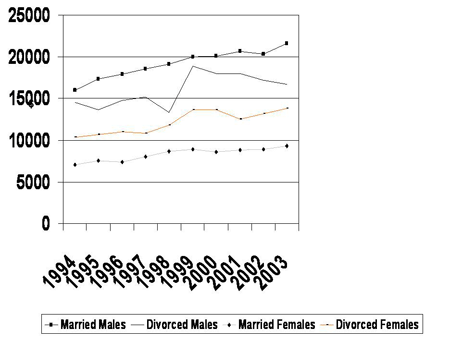
Figure 10 shows some of the quality of life differences found in the National Longitudinal Surveys-Mature Women data set (yes, this is an example of secondary analysis research). Elderly divorced and widowed women were more likely to still be in the labor force than married ones. Married women had the lowest levels of reported unhappiness and rarely enjoying life. Feeling sad was similar among all categories.
Figure 10. Quality of Life Measures for Elderly Women. Comparing Marital Status from National Longitudinal Surveys-Mature Women, 2003
Roles of Grandparents
The role of grandparent is a socially acceptable one in the U.S. It is admired by others, bragged about by grandparents, and more often than not appreciated by grandchildren. Grandparents are given social approval by peers and society in general for being in that role. Grandparents also can be as actively or inactively involved as they desire. There are varying types of grandparental involvement, and I've developed a few types just for comparison purposes here.  Most U.S. grandparents live in another household from their grandchildren. But economic uncertainties and demographic changes with lower birth rates may contribute to the U.S. returning to three- or four-generational households (see Pew Research Center: Social and demographic Trends, Monday Feb. 11, 2008 “US Pop. Projections: 2005-2050 by Passel and Cohn).
Most U.S. grandparents live in another household from their grandchildren. But economic uncertainties and demographic changes with lower birth rates may contribute to the U.S. returning to three- or four-generational households (see Pew Research Center: Social and demographic Trends, Monday Feb. 11, 2008 “US Pop. Projections: 2005-2050 by Passel and Cohn).
The “Disneyland Grandparents” entertain and distract their grandchildren from the mundane aspects of their daily lives at home. These grandparents provide a certain entertainment option that is missing for the children's not-yet established parents. Grandchildren come to have high expectations of indulgence when spending time with these grandparents.
The “Assistant Parent” grandparent is the one who takes the grandchildren to school functions, practices, and doctors appointments or waits for the grandchildren to come to their house after school and before the parents return home from work. Because the parents are typically both employed, these grandparents sometimes become an integral part of their grandchild's daily life and have an ongoing supportive role in the grandchild's busy schedule. Many young dual-employed couples could not afford the cost of formal daycare, and many grandparents feel rewarded by the meaningful contribution they make in this role.
The “Parental Substitute” grandparent is the one who lives in the home with the grandchild (or the grandchild lives in the grandparent's home). This is an older family member who is drawing retirement, depends heavily on Medicare for their medical expenses, and is typically in declining health. These grandparents have a great deal of stress that often reminds them of the original parental stresses they faced when they were raising their own children. The Parental Substitute grandparents often express fatigue and feeling overburdened.
Raising grandchildren is not what most grandparents anticipated to happen in their later lives. Grandparents in the U.S. often have direct daily interaction with their grandchildren. The U.S. Census Bureau estimates over 6 million grandparents do have their grandchildren living in their home (retrieved 9 February 2010 from http://www.census.gov/Press-Release/www/releases/archives/facts_for_features_special_editions/012095.html). This type of grandparent is common when unwed teen mothers keep their babies, when an adult child is divorced or widowed, or when a child or son/daughter-in-law becomes disabled.
Finally, there is the “Distant Relative” grandparent. These grandparents visit at times and live at a geographic or emotional distance from their grandchildren. They typically can't or will not have a close relationship with the grandchildren. Telephones and the Internet allow these grandparents to consult with the parents and be intermittently involved in the lives of their children and grandchildren, but many grandchildren experiencing this type of grandparenting often report a disconnect to these grandparents.
Grandparents can have a positive and nurturing impact on their grandchildren, or they can have a shameful and negative one. Some grandparents work diligently to reinforce the value of each individual grandchild, often trying not to repeat the same mistakes they made when raising their own children. These grandparents find ways to show and express their love, support, and valuation of the grandchild.
Other grandparents repeat the shameful patterns of parenting that they mistakenly used in their own parenting efforts. They label grandchildren and shame them as a form of control and discipline. When asked this question, “If you had to use a negative or positive symbol to portray how your grandma or grandpa views you, which would it be and why?”, grandchildren will indicate to some degree the nature of their relationship to their grandparents and how they perceive a low esteem that these grandparents have for them.
Elder abuse is a significant problem in modern U.S. families. I will give you just a short mention of it in this chapter so you can contemplate some of the facts, and in chapter 16 I'll cover family violence and tragedies in more detail. Elder Abuse is the mistreatment of, violence against, and otherwise harmful manipulation of elderly persons. Marlene Lee (2009) reported that elderly abuse is too common (retrieved 10 February 2010 from http://www.prb.org/Articles/2009/familyandhealth.aspx). She reported that fewer than 10 percent of U.S. elderly are abused in any way, and that verbal abuse was the most common form. She also reported that non-family persons accounted for more than half of all elderly abuse. When a family member was verbally abused, it was more likely to be from a spouse. Financial and physical abuse were more likely to be inflicted by a child.
